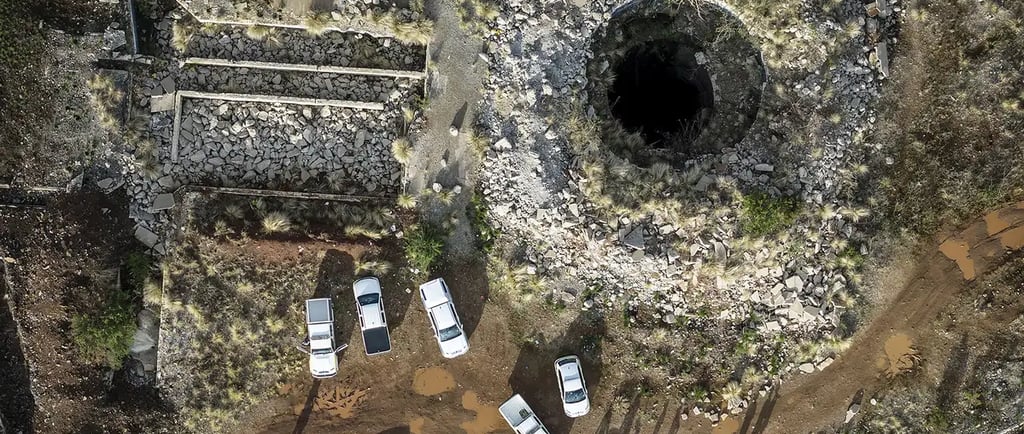Beneath the Surface: South Africa's Shadow Mines and the High Cost of a Hidden Economy
Nashwa Abdel Nabi – Political Researcher
8/20/20253 min read


Deep beneath the surface of South Africa, in the abandoned shafts of once-mighty gold mines, a shadow economy thrives. Here, tens of thousands of men known as zama zamas—a Zulu term meaning "those who try their luck"—risk their lives daily. Armed with rudimentary tools, they chip away at the earth in treacherous, unregulated conditions, all for a chance to find a sliver of gold.
This is the face of informal mining in South Africa, a nation built on a formal mining empire. It is a dangerous, often violent world, but for many, it is the only world offering an income. This phenomenon is not just a crime problem; it is a stark symptom of a deeper national crisis fueled by staggering unemployment, deep-seated inequality, and a legacy of social exclusion.
The scale is significant. An estimated 30,000 informal miners now operate in South Africa, producing roughly 10% of the country's annual gold output. This unregulated industry is a powerful force, but its true cost—to the economy, the environment, and human lives—is devastating.
Why Here? Why Now? The Roots of the Crisis
The rise of the zama zamas is not accidental. It is the direct result of a perfect storm of economic and political failures that have pushed people to the margins.
A Legacy of Exclusion and Poverty: Decades after apartheid, extreme economic inequality persists. With formal unemployment rates exceeding 30%, millions are locked out of the official economy. For them, the perilous descent into a shadow mine is a desperate act of survival.
A Vacuum of Governance: Widespread corruption and the state's diminished capacity to enforce laws create fertile ground for unregulated activities. In remote mining regions, the government's presence is often weak, leaving a void that criminal networks and informal economies rush to fill.
A System That Locks People Out: The formal mining sector is dominated by large corporations, with complex legal procedures that make it nearly impossible for small-scale miners to operate legally. This creates a deep sense of injustice, driving local communities to extract resources independently of a state they feel has abandoned them.
A Ripple Effect of Devastation
While informal mining provides a lifeline for some, it casts a long shadow of destruction across society, the environment, and the state itself.
1. Fuel for Conflict and Crime
The competition for control over mineral-rich areas has turned many mining communities into violent battlegrounds. The zama zamas are often entangled with transnational criminal syndicates that smuggle gold, launder money, and finance other illicit activities. In this "war economy," natural resources fuel conflict instead of development.
2. The Erosion of Law and Order
The widespread nature of illegal mining undermines the rule of law. As authorities are either unwilling or unable to intervene, a culture of impunity takes hold, creating lawless zones where state sovereignty is little more than a concept. This erosion of public trust and institutional control poses a direct threat to national stability.
3. A Drain on the Formal Economy
Illegal mining deals a massive blow to the national treasury. In 2010, South Africa lost an estimated $500 million in gold revenues, with current annual losses still in the millions. This lost tax revenue starves public services of essential funding, while the dominance of illicit networks weakens the formal mining sector.
4. An Environmental Catastrophe
With no oversight, informal mining operations cause catastrophic environmental damage. The use of toxic substances likemercury pollutes rivers and groundwater, while unsafe digging practices lead to soil degradation and deforestation. This unchecked destruction threatens food security, public health, and the long-term sustainability of the very resources being exploited.
South Africa’s Contradictory and Failing Response
Despite the escalating crisis, the South African government's response has been inconsistent and largely ineffective. The official policy has oscillated between outright criminalization and half-hearted attempts at formalization, succeeding atneither.
The Ministry of Mineral Resources has largely refused to grant licenses to artisanal miners, viewing them as a problem to be eradicated rather than a reality to be managed. At the same time, security agencies are often under-resourced and reluctant to intervene in the deep, high-risk mine shafts, creating a regulatory vacuum where the practice continues to expand unchecked.
By treating informal mining solely as a criminal issue, the government ignores its root causes: poverty and desperation. As long as millions of people have no viable economic alternatives, the lure of the shadow mines will remain irresistible.
Conclusion: Beyond a Security Problem
Informal mining in South Africa is far more than an unregulated industry; it is a powerful reflection of state weakness, social injustice, and a failed development model. A strategy focused purely on security crackdowns is doomed to fail because it addresses the symptoms, not the disease.
Addressing this complex challenge requires a comprehensive, two-pronged approach. First, it demands smart, practical regulation that creates pathways for formalization, ensuring safer working conditions and allowing the state to capture revenue. Second, and more importantly, it requires a genuine commitment to creating real economic alternatives through inclusive development, job creation, and a fair distribution of the nation's immense natural wealth.
Without this holistic strategy, the shadow mines will only grow deeper, pulling more lives and the nation's future down with them.
Download full study here.
Empowerment
Amplifying African voices for sustainable progress together.
Contact US
Growth
Street No. 3281, N'Djamena, Republic of Chad.
© 2024. All rights reserved.